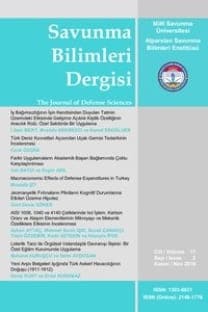Uluslararası Pisa Test Sonuçlarının Yapay Sinir Ağları ve Regresyon Yöntemleri ile Değerlendirilmesi
Öz Yapay sinir ağları geleneksel yöntemlerin çözemediği akışları analiz etmede oldukça etkili olabilmektedir. Bu çalışmada Türkiye ve Ekonomik İş birliği ve Kalkınma Teşkilatı (OECD) PISA bilim seviyesi değerleri ile giriş-çıkış katmanlarında tan-sigmoid iletim fonksiyonlu iki katmanlı ileri besleme yapay sinir ağı kullanılmıştır. OECD Uluslararası Öğrenci Değerlendirme Programı (PISA) her üç yılda bir okuma becerilerini, matematik ve fen başarı performanslarını test etmektedir. PISA değerlendirmesi, gençlerin bilgi ve becerilerini sahip oldukları müfredat tabanlı bilgiye değil, gerçek yaşamdaki sorunlara ve durumlara uygulama becerileri üzerine odaklanmaktadır. Değerlendirmeler okuma-yazma, matematiksel okuryazarlık ve bilimsel okuryazarlık olmak üzere üç ana alanda yürütülmektedir. Sonuç olarak, PISA’nın önemli bir küresel kıyaslama aracı olduğu görülmekte, ancak politika yapıcıların ve medyanın, toplanan zengin verilerle birlikte öğrencilerin akademik performanslarıyla ilgili bilgileri kullanarak daha iyi değerlendirmelerde bulunmaları gerekmektedir. Yapılan istatistiksel değerlendirmelere göre yapay sinir ağları yaklaşımının regresyon analizine göre daha yüksek değerler verdiği tespit edilmiştir. Anahtar Kelimeler: PISA, Yapay Sinir Ağları, Regresyon Yöntemi.
Anahtar Kelimeler:
PISA, Yapay Sinir Ağları, Regresyon Yöntemi
Examination of International Pisa Test Results with Artificial Neural Networks and Regression Methods
Abstract It is approved that artificial neural networks are considerably effective in analyzing flows in which traditional methods and statics are inadequate to solve. In this article, we use a two-layer feedforward network with tan-sigmoid transmission function in input and output layers with PISA of Turkey and Organisation for Economic Cooperation and Development (OECD) science level values. OECD Programme for International Student Assessment (PISA) surveys reading, mathematical and scientific literacy levels every three years. The PISA assessment works on young people’s ability to apply their knowledge and skills to real-life problems and situations rather than on how much curriculum-based knowledge they have. Assessments are made on three core fields reading literacy, mathematical literacy and scientific literacy. The conclusion is that PISA is an important global benchmarking tool, but that bureaucrats and the media need to use the rich data that have been collected together with information about their academic performance. According to statistical evaluations, regression value of ANN was higher than value of regression methods.Keywords: PISA, Artificial Neural Networks, Regression Methods.
Keywords:
PISA, Artificial Neural Networks, Regression Methods,
___
- References
- Books
- Çepni, S. (2016). PISA ve TIMMS Mantığını ve Sorularını Anlama. Pegem Akademi Yayınları. s:312, doi:10.14527/978605318359. Demuth, H., and Beale, M. (1993). Neural Network Toolbox For Use with Matlab--User'S Guide. Version 3.0. Hopgood, AA.(2000). Intelligent systems for engineers and scientists. Florida: CRC Press. Krenker, A, BešTer, J, Kos A. (2011). Introduction to the Artificial Neural Networks, Artificial Neural Networks - Methodological Advances and Biomedical Application. Prof. Kenji Suzuki (Ed.)., ISBN: 978-953-307-243-2.
- Articles
- Anıl, D. (2008). The Analysis of Factors Affecting the Mathematical Success of Turkish Students in the Pisa 2006 Evaluation Program with Structural Equation Modeling. American-Eurasian Journal of Scientific Research 3 (2): 222-227. Demir, İ. and Depren, Ö. (2010). Assessing Turkey’s secondary schools performance by different region in 2006, Procedia Social and Behavioral Sciences 2: 2305–2309. Ünal, H. and Demir, İ. (2009). Divergent thinking and mathematics achievement in Turkey: Findings from the programme for international student achievement (PISA-2003). Procedia Social and Behavioral Sciences 1: 1767–1770. Demir, İ. and Kılıç, S. (2009). Effects of computer use on students’ mathematics achievement in Turkey. Procedia Social and Behavioral Sciences: 1802–1804. Alacacı, C., and Erbaş, A.K. (2010). Unpacking the inequality among Turkish schools: Findings from PISA 2006. International Journal of Educational Development, 30(2), 182-192. Aydın, A., Sarıer, Y., & Uysal, Ş. (2012). Sosyoekonomik ve sosyokültürel değişkenler açısından PISA matematik sonuçlarının karşılaştırılması. Eğitim ve Bilim, 37:164-175. Yorulmaz, Y. İ., Çolak, İ., & Ekinci, C. E. (2017). OECD ülkelerinin PISA 2015 başarılarının gelir dağılımı ve eğitim harcamaları açısından değerlendirilmesi. Turkish Journal of Education, 6(4), 169-185. Hann, TH, Steurer, E. (1996). Much ado about nothing? Exchange rate forecasting: Neural networks vs. linear models using monthly and weekly data. Neurocomputing; 10:323- 339. Valipour, M. (2016). Optimization of neural networks for precipitation analysis in a humid region to detect drought and wet year alarms. Meteorological Applications, 23(1), 91-100. Albayrak, A. S. (2012). Çoklu Doğrusal Bağlantı Halinde Enküçük Kareler Tekniğinin Alternatifi Yanlı Tahmin Teknikleri ve Bir Uygulama. Uluslararası Yönetim İktisat ve İşletme Dergisi, 1(1), 105-126. Jain, A. K., Mao, J., and Mohiuddin, K. M. (1996). Artificial neural networks: A tutorial. Computer, 29(3), 31-44.
- Internet Sources
- PISA (2017). The Programme for International Student Assessment (PISA). It was taken from http://www.oecd.org/pisa/aboutpisa/(English) on 09.01.2017. MEB (2009) Uluslararası Öğrenci Değerlendirme Programı PISA 2009 Ulusal Ön Raporu. It was taken from http://pisa.meb.gov.tr/wp-content/uploads/2013/07/pisa-2009-ulusal-on-rapor.pdf (Turkish) on 09.01.2017.
- Thesis
- Toprak, E. (2017). Yapay Sinir Ağı, Karar Ağaçları ve Ayırma Analizi Yöntemleri ile PISA 2012 Matematik Başarılarının Sınıflandırılma Performanslarının Karşılaştırılması. Hacettepe Ünv. Y.Lisans Tezi.
- ISSN: 1303-6831
- Yayın Aralığı: Yılda 2 Sayı
- Başlangıç: 2002
- Yayıncı: Milli Savunma Üniversitesi Alparslan Savunma Bilimleri ve Millî Güvenlik Enstitüsü
Sayıdaki Diğer Makaleler
Kişi Örgüt Uyumunun Örgütsel Adalet Algısı ve Örgütsel Bağlılık İlişkisinde Aracılık Rolü
Çin Dış Politikasında İttifak Yapmama Prensibi: Akademik Tartışmalar
Küresel Güvenliğin Dönüşümü; NATO Bağlamında Kavramsal, Tarihsel ve Teorik Bir Analiz
Uluslararası Hukuk Çerçevesinden Arktik Güvenliği Politikalarının Analizi: Rusya ve ABD Örneği
Uluslararası Pisa Test Sonuçlarının Yapay Sinir Ağları ve Regresyon Yöntemleri ile Değerlendirilmesi
